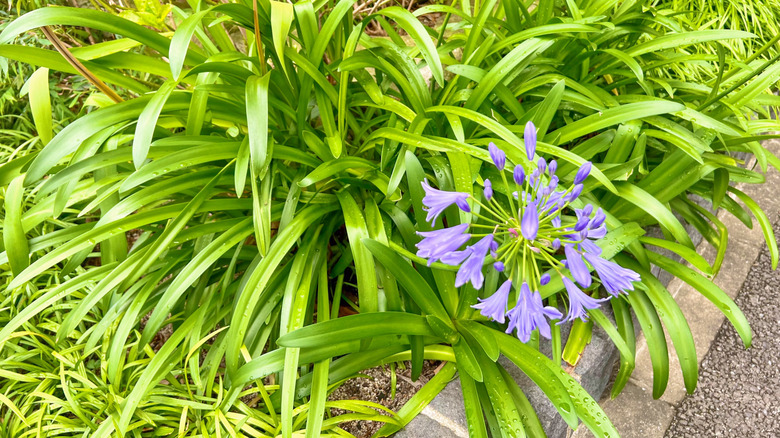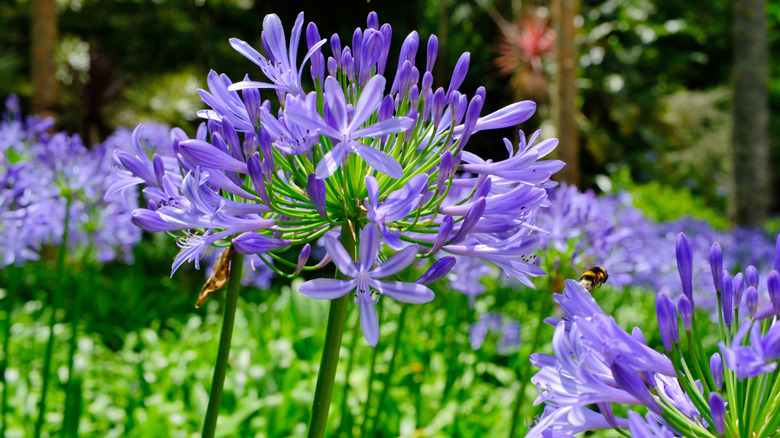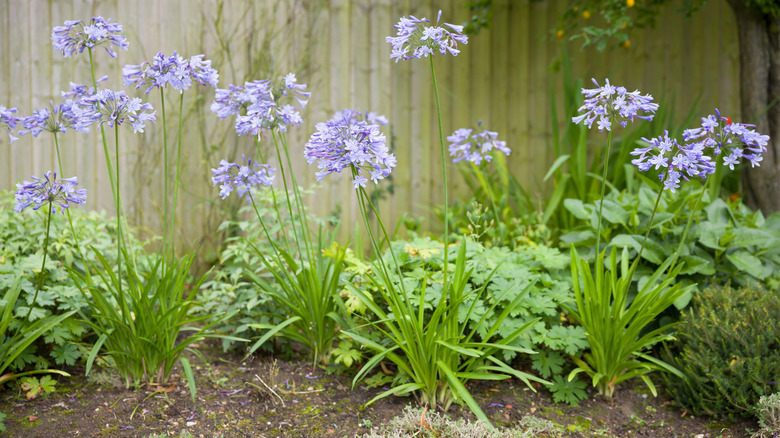Reasons Your Agapanthus Plant Isn't Flowering (& The Easy Way To Fix It)
Having agapanthus in your garden can easily get on your nerves, considering the plant's erratic flowering behavior. For instance, it can bloom with such jaw-dropping flowers one season, that you can't get your eyes off them to attend to other plants. At other times, these finicky, hard-to-please members of your garden refuse to blossom at all, making you wonder what went wrong. While gardeners are happy when the blooms do come out, it's not that difficult to turn non-flowering plants into stunning bloomers, if you know how. Most of the time, it's one of three things that go wrong — not enough sunlight, too much or too little water, or insufficient nutrients. Get this holy trinity of agapanthus-gardening fixed, and before long, the same plant that refuses to bloom will start to lure hummingbirds to your yard with bright blue flowers they can't resist.
Agapanthus is a plant genus that has had more than its fair share of taxonomic excursions -– being placed alongside onions, amaryllis, and lilies -– until it finally found a home in a family of its own (Agapanthaceae). The plant takes at least a couple of years to flower, so the first thing you need to do is stop panicking if you planted it in fall and can't see any colors the following spring. But if your plants are a bunch of seasoned warriors and you're still witnessing a no-show from them, you probably made a mistake a while back. Since agapanthus flower buds start developing within the bulbs by the end of summer, not receiving enough sunlight or nutrients during this time is often detrimental for the blooms next spring.
Give your agapanthus plenty of sun and just enough water
Since these plants have traveled all the way from South Africa (although the common name Lily-of-the-Nile may suggest a slightly different origin story), it is natural that they display a sunny disposition and like a lot of sunlight for flowering. In fact, the sturdy stems of its flowers literally reach out for the sun and can get quite leggy when put in shade. Optimum sunlight is a crucial item to check off for most plants to flower, but when it comes to agapanthus, this means an indispensable 6 to 8 hours of sun every day. No wonder you can find them thriving alongside marram grass in the sand dunes of the Isles of Scilly! What this also means is that these sun-loving beauties will refuse to oblige you with their blooms if you keep them in partial shade, unless it's really hot outside, and even then, all the plant needs is a short respite from the scorching afternoon sun.
Depending on the season, you also need to be highly cognizant of the amount of water you give the plant to ensure good flowering. Agapanthus needs its fair share of watering when it is hot and dry outside. However, during winters, all you need to do is make sure the leaves don't wilt and you're good. An excellent way to decide whether your agapanthus is short on water or not is to check the top 3 inches of the soil for moisture. Push your finger inside the soil, and whenever it begins to feel dry, give the plant a deep drink.
Feed your agapanthus with the right nutrients
Despite being considered a hardy species (its invasive status is definitely what you need to know before planting agapanthus flowers in your garden), it does not like being planted in sandy soil that is low on nutrients, and this affects its flowering patterns as well. Agapanthus needs fertilizing about twice a year — once during early fall and again during early spring — with a low nitrogen formulation that also contains phosphorus. Excessive nitrogen often leads to unnecessary foliage growth and restricts flowering. You can also get tremendous results from using a soluble, potash-rich feed, diluting it with water, and feeding this to the plants.
Remember what we said about agapanthus being finicky? Well, their roots are another case in point. In short: They like being left alone. Bother them too much by trying to divide them or repotting them into a bigger pot, and they will remember you and punish you with very little flowers the next season. The jury is still out on whether they absolutely need cramped spaces to flower, but you can leave them undisturbed for years and still enjoy garden flowers that will have summer beds bustling with colors.


